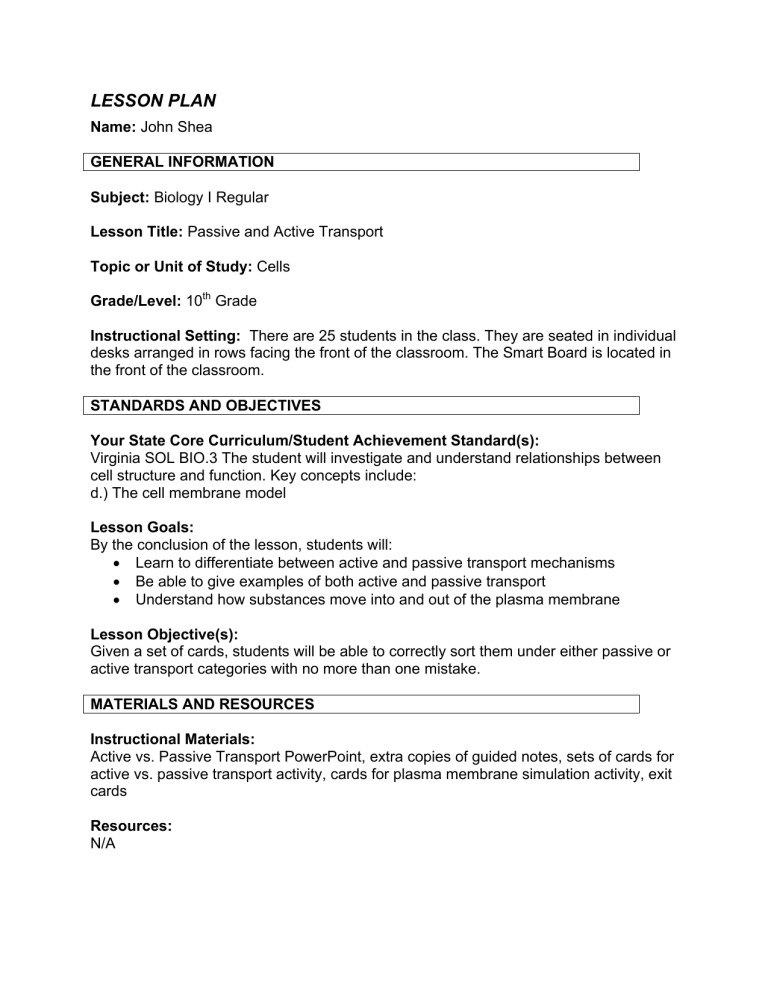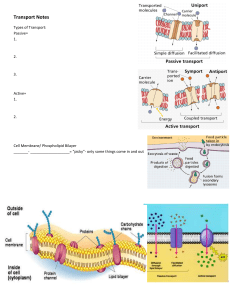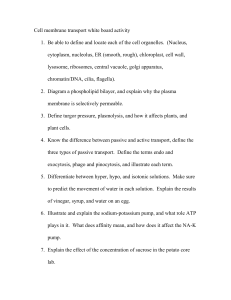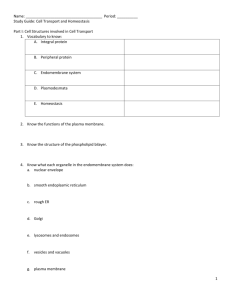
LESSON PLAN Name: John Shea GENERAL INFORMATION Subject: Biology I Regular Lesson Title: Passive and Active Transport Topic or Unit of Study: Cells Grade/Level: 10th Grade Instructional Setting: There are 25 students in the class. They are seated in individual desks arranged in rows facing the front of the classroom. The Smart Board is located in the front of the classroom. STANDARDS AND OBJECTIVES Your State Core Curriculum/Student Achievement Standard(s): Virginia SOL BIO.3 The student will investigate and understand relationships between cell structure and function. Key concepts include: d.) The cell membrane model Lesson Goals: By the conclusion of the lesson, students will: Learn to differentiate between active and passive transport mechanisms Be able to give examples of both active and passive transport Understand how substances move into and out of the plasma membrane Lesson Objective(s): Given a set of cards, students will be able to correctly sort them under either passive or active transport categories with no more than one mistake. MATERIALS AND RESOURCES Instructional Materials: Active vs. Passive Transport PowerPoint, extra copies of guided notes, sets of cards for active vs. passive transport activity, cards for plasma membrane simulation activity, exit cards Resources: N/A INSTRUCTIONAL PLAN Identification of Student Prerequisite Skills Needed for Lesson: Students will use their knowledge of the plasma membrane, selective permeability, homeostasis, solutes and solvents, and proteins and lipids from previous lessons during the current and previous chapters. Sequence of Instructional Procedures/Activities/Events 1. We will begin the lesson by reviewing the plasma membrane model, osmosis, and isotonic, hypotonic, and hypertonic solutions. 2. I will use PowerPoint to present new information on active and passive transport mechanisms. Students will fill in the blanks on their guided notes as I present this information. 3. Students will work with partners to compete an active vs. passive transport card sorting activity. Each pair of students will receive a baggie with a set of cards in it. Included in each bag are Active and Passive Transport labels. Students will need to correctly sort the remaining cards in the bag under either Active or Passive Transport. 4. We will then split the class into two groups. One group will go next door with Mrs. German (Special Education collaborative teacher) and/or Mrs. Dean, and the other group will stay with me. We will use individual students to simulate the plasma membrane model. Several students will be chosen as parts of the bilipid layer and will stand facing each other with their arms out (bodies = hydrophilic heads, arms = hydrophobic tails). Other students will represent transport proteins and will stand in the bilipid layer and transport substances into and out of the cell. The remainder of students will represent water molecules or solute molecules and we will demonstrate how each of these substances move through the plasma membrane. Culminating or Closing Procedure/Activity/Event: Each student will be given an exit card to fill out and turn in before they leave class. The exit card will ask students to list the topic(s) from this unit that they still don’t feel comfortable with. This information will be used to develop a review for the upcoming unit test. Pedagogical Strategy (or Strategies): Direct Instruction, Hands-on activities with partners/groups. Differentiated Instruction: There are five SPED students and two ESL students in this class. These students will require no specific accommodations during this lesson, however they will benefit from the variety of activities used. This lesson is intended to meet the needs of all students who learn differently by using a variety of activities, including the PowerPoint presentation (auditory and visual learners), the hands-on card sorting activity (visual learners, kinesthetic learners), and the plasma membrane simulation (visual learners, kinesthetic learners). Student Assessment/Rubrics: I will formatively assess students on material from the previous two lessons through the review at the beginning of class. I will also assess how well they understand active and passive transport by walking around during the card sorting activity to ensure that they are placing their cards in the correct categories. The exit cards will also let me know what areas students do not yet fully understand so that I can focus on those during our review before the test on Wednesday.


